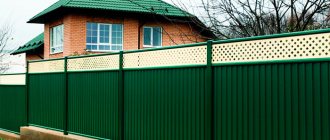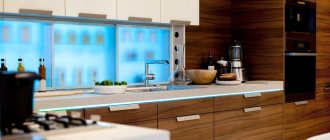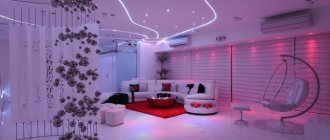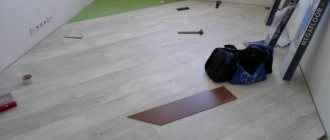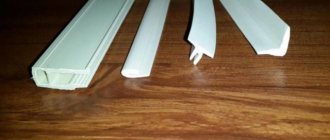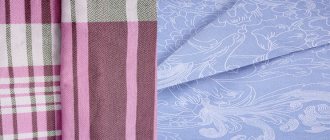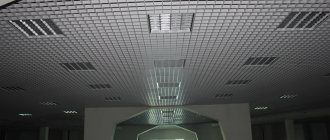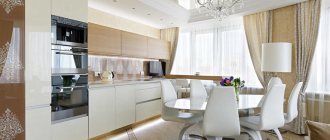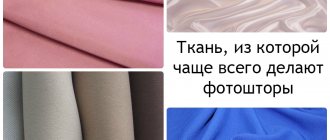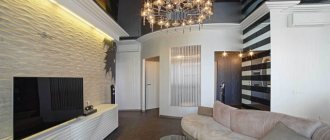The undeniable attractiveness of suspended ceilings is associated with the speed of installation and the ability to carry it out in rooms with finished finishing. Glossy canvases are increasingly giving way to elegant satin and matte finishes, gaining space under the ceiling only in pop art and hi-tech styles. And yet doubts remain: which material to prefer - fabric or PVC? Each solution has advantages and disadvantages, but the advantages of fabric stretch ceilings objectively outweigh their minor disadvantages. Let's take a closer look at why textile fabrics are good, what they are made from, how to avoid fakes and complement the interior with an elegant ceiling.
What is a fabric stretch ceiling and what does it look like?
Fabric panels used for the installation of suspended ceilings are produced by weaving polyester threads followed by polyurethane impregnation to increase moisture-repellent properties. Polyester is a synthetic material that resembles wool in appearance and has similar characteristics to natural cotton.
Due to the specifics of production, the canvases are made only in matte versions, but they can imitate natural suede, chintz fabric, or be made in two layers - when an embossed layer is applied to the mesh base.
These features provide fabric stretch ceilings with a solid and noble appearance.
Reviews
Let's see what people write about who have installed suspended fabric ceilings in their apartments.
- Elena, 35 years old, Moscow: “I installed a suspended fabric ceiling in my home. At first I decided to try it - I did it only in the living room, but now I have such ceilings in all the rooms. I am very pleased - the apartment immediately took on a different look - chic and aesthetic. I didn’t even expect that the appearance of an apartment could change so much for the better just by changing the ceilings.”
- Maria, 50 years old, Saratov: “We live outside the city, we have a two-story large house. The whole family thought about what kind of ceilings to make in it, we considered options with foam plastic tiles and film ones, but in the end our friends convinced us that fabric ceilings are much more beautiful, more natural and look better. We chose them and did not regret it. Now in each of the rooms we have an individual design on the ceiling - all the guests are surprised and delighted. We are glad. The installation went without any problems, the technicians completed everything in a few days.”
We have considered all the advantages and disadvantages of stretch fabric ceilings. As you can see, there are many more advantages, and, compared to film analogues, a fabric ceiling is still preferable. Choose the ceiling wisely - and your home will acquire a beautiful and stylish look for a long time.
Types of fabric stretch ceilings
The choice of ceiling fabric decors is much more modest than that of budget PVC analogues. And yet there is quite enough scope for the implementation of design ideas.
White canvas
The traditional white color is still in demand when finishing ceilings; in addition, manufacturers take special care to control the uniformity of the shade over the entire surface of the material. From the point of view of economic feasibility, this material is the most attractive, since the price is slightly higher than the cost of a PVC ceiling, and the already installed canvas can be repainted up to four times.
Colored fabrics
Despite the fact that the choice of colors does not exceed two dozen, these ceilings are no less popular. Their cost is higher than that of white canvas, but this is compensated by exceptionally smooth and deep matte shades. The absence of surprises is also important - the consumer is already sure at the project stage what color the ceiling covering will be.
Glitter
This is a solution for those who find matte ceilings boring - in such cases, you can choose textiles with soft shimmer or splashes of glitter. With the right lighting, you can achieve interesting visual effects. However, the cost per square meter of stretch ceiling will differ significantly and upward.
Acoustic ceilings
The use of special woven materials for suspended ceilings allows you to get rid of unpleasant acoustic effects - manufacturers offer fabrics with special substrates that eliminate the occurrence of echoes. Such fabrics are in demand when decorating recording studios and other special-purpose premises.
Translucent fabrics
This type of fabric allows you to create interesting ensembles due to the lamps located above the ceiling level. But there are also “pitfalls” - if the lighting fails during operation, then it will not be possible to dismantle the ceiling and then install it again. Therefore, special attention will need to be paid to the selection of lighting equipment, focusing on the longest manufacturer warranties.
Photo printing
The most expensive option of all types of fabric ceilings, allowing you to add individuality to the interior. The choice of subjects is not limited; photographs provided by the customer are also used. The only condition is high image quality, since the textured surface of the material somewhat blurs the clarity of the picture.
Disadvantages of ceiling fabrics
Despite the visible advantages, there are also certain negative nuances:
- not completely environmentally friendly. Fabric stretch ceilings consist of synthetic polyester.
- no resistance to major flooding. PVC coating is able to hold and not let water through in case of possible flooding, while fabric ceilings hold for some time, and then break out of the fastenings, and all the water spills.
- lack of breathability. Due to the special impregnation of nylon threads, this function is completely absent.
- quite high cost. Despite the fact that it can save on basic finishing work, the price is still twice as high compared to other types of suspended ceilings
- the option of dismantling is excluded. Even if you are tired of the ceiling design, it cannot be changed. A mirrored and glossy appearance of a fabric ceiling covering is not possible. You have to choose from 20 matte shades.
Benefits of fabric
The main advantage of fabric canvases is that this is the only modern material that allows for seamless finishing of the ceiling with a minimal reduction in the height of the walls - with the correct geometry of the room, only 15 mm will be required for a suspended ceiling. Moreover, the costs for such finishing will be lower than for plastering and painting work. However, the list of advantages is quite extensive:
- Frost resistance . Fabric ceilings can be considered for unheated rooms; even at -40, the material retains its original elasticity and does not become brittle.
- Resistance to elevated temperatures . Operation is possible at temperatures up to +80 degrees, which allows the use of canvases in attic spaces.
- Seamless . The width of the roll reaches 5.1 meters, which, taking into account the installation allowance, is a full 5 meters of a single surface.
- Antibacterial . Ceiling fabrics are not susceptible to the spread of fungal mold and bacteria.
- Durability . The material is resistant to mechanical stress. It can be damaged by deliberate effort, but it will not be possible to accidentally break through the canvas by catching it with skis or a stepladder.
- Fire safety . All fabrics are impregnated with special compounds, due to which they do not support the spread of fire and cannot cause rapid smoke.
- Hygroscopicity . Fabric sheets briefly retain water, while allowing steam and moisture to pass through, allowing the ceiling beams to “breathe” and do not create a greenhouse effect.
- Versatility . Fabric ceilings are stretched in cases where heating with guns is impossible.
- Aesthetics . In the area where the lamps are attached, yellow spots or unevenness do not appear, like with PVC sheets.
In general, it can be argued that the advantages of fabric stretch ceilings more than compensate for their disadvantages.
Pros and cons of textile ceilings
| Advantages | Flaws |
| No smell. | Doesn't hold water. If a large amount of water gets in, the material deteriorates. Can only hold water for 12 hours. |
| Strength. Resistant to temperature changes, does not crack from frost. Resistant to mechanical stress. | |
| Durability. They do not fade and retain their original appearance. | If a small section is damaged, the entire tension structure will have to be replaced. |
| Easy installation. No preparatory work is required. | |
| Possibility to change color. Can be repainted about four times. | |
| Soundproofing. | Seamless option only 5 meters. If the room is larger than this size, a seam will have to be applied. |
| Antiseptic. Does not absorb dust. | |
| The tension covering is fire-resistant. | |
| Completely safe for health. | The cost is higher than that of PVC ceilings. |
| Possibility of applying any images using photo printing. | |
| Breathing. Provides a normal level of air circulation. |
The photo shows a white fabric ceiling in the living room interior.
Disadvantages of fabric fabric
The main disadvantage is the inability to re-install the fabric. You can’t stretch the ceiling, decide that photo printing would look better, dismantle it to apply the design, and then install it again. If the interior looks unfinished due to the monochrome ceiling, then there are few options: hand painting or new fabric.
Also, the disadvantages include the following nuances:
- a limited number of “native” fillets for decorating classic interiors, difficulties with attaching arbitrary decorative elements;
- the need to avoid fabric joints so as not to use special linings;
- operation in rooms with moderate humidity, otherwise dirty streaks are likely to appear.
It should be noted that fabrics absorb tobacco smoke, so smoking in rooms with such a ceiling is not recommended.
Negative sides
Having considered all the advantages, it is necessary to dwell on the disadvantages of suspended fabric ceilings.
There is a possibility of leaks
If you are flooded from above or the roof of a private house is leaking, then the stretch fabric ceilings will not hold up - water will flow, ruining the entire structure. But if, say, you choose a ceiling from the Cerutti brand, then you can avoid this problem - the ceilings of this brand do not allow water to pass through.
Expensive price
This is one of the most significant disadvantages of tension structures. Not everyone can afford such ceilings. Film analogues are cheaper, however, they are made of artificial material, and therefore are not as environmentally friendly and do not provide such a good microclimate as natural fabric ones.
Problems in care
Some owners of suspended fabric ceilings claim that caring for them is much more difficult than film ones. PVC film can simply be wiped to make it clean, but natural fabric requires a more careful and careful approach. In addition, the fabric absorbs odors - smoking in such rooms is strictly not recommended - the smell of cigarettes will remain for a long time.
Fabric ceilings accumulate a lot of dust, which is why they need to be vacuumed constantly. In addition, you need to choose a special vacuum cleaner for this - not all types are suitable.
But compared to ceilings made of PVC film, fabric analogues win on almost all counts. They are more aesthetically pleasing, environmentally friendly, and easy to install. However, they require more thorough cleaning and are more expensive.
Popular manufacturers and how to recognize a fake
The technology for producing fabrics for suspended ceilings is relatively young, but over the past decade and a half, three manufacturers have earned the trust of consumers:
- Cerruti (Cerutti) - Switzerland.
- Descor (Deskor) - Germany.
- Clipso (Clipso) - France.
The fabrics of all these brands are distinguished by their density, increased moisture resistance, and uniform thread weaving. The collections include translucent, acoustic, snow-white, suede and double fabrics with various patterns. Rolls are available in widths of 310, 350, 410, 450 and 510 cm.
There are very few counterfeit products on the market, since PVC is easier to counterfeit than fabric materials. But if suddenly the price is unexpectedly low, then this is a reason to be wary - standard fabric ceiling solutions cannot cost less than 500 rubles per square meter. It is also worth paying attention to the quality of packaging - world-class manufacturers supply rolls with inserts describing the characteristics of the material and symbols for its use. And the packaging itself is branded - it contains logos and company names.
Production of fabric ceilings in the world
The leading market leaders in the manufacture of this product are Descor and Clipso. The fabric for suspended ceilings is of approximately the same quality.
When choosing this ceiling covering, you should pay attention to the trademark placed along the edges of the material. You definitely need to pay attention to this so as not to fall for a fake.
As a comparison, we can say that PVC film does not have such special marks, so it is difficult to distinguish a Chinese-made material from a European one.
Both leading companies are focused (Descor and Clipso) on the production of fabric ceilings that meet all modern requirements, and have mandatory certificates for this.
When choosing between two manufacturers, preference should be given to Clipso. Such fabric ceilings are more durable and better to work with.
All other companies on the market are ordinary resellers and have nothing to do with the production of this product.
Installation technology
Since the fabric does not stretch, it does not need to be heated. This allows installation in small spaces to be carried out alone without special skills. However, it should be remembered that there is always a risk of insufficient tension of the material, and it cannot be dismantled for reuse. Therefore, in large and geometrically complex rooms it will not be possible to do without specialists or qualified assistants.
The installation process can be divided into six stages:
- Marking the level and location of lighting fixtures (according to previously completed wiring).
- Adjustment of fixing baguettes to the size of the perimeter of the room.
- Installation of baguettes.
- Fabric stretching.
- Trimming the excess.
- Decoration with ceiling plinth.
If the room is furnished, then the interior items must be covered with film or fabric. With flat ceilings, it is enough to step back 1.5-2 cm from above and mark the level.
It would be a good idea to check the integrity of the wiring to be sure that you won’t have to work with electricians for a long period of time.
Then holes for dowels are drilled around the perimeter of the ceiling at a distance of approximately 10 cm, baguettes are applied and secured with self-tapping screws.
The roll of fabric needs to be unrolled and left for a while to straighten out. After half an hour, you can begin installing the canvas, for convenience, fixing its corners with crocodile clothespins. You can do without them if you have someone to hold the canvas suspended.
Using a rounded spatula, you need to push the fabric into the baguettes, starting from the smaller walls (if the room is rectangular and not square), or from two opposite ones. From the conventional middle of the wall, you should alternately move to the corners of the room, fixing the fabric. This is the most critical stage, requiring careful and unhurried work so that the canvas is tensioned evenly.
After the fabric is fixed, you need to trim its excess with a construction or stationery knife so as not to touch the stretched fabric. Most likely, this will not be done perfectly, so the last step is gluing the decorative fillets.
Important: glue or sealant should be chosen colorless and applied only to the edge that is fixed to the wall.
If possible, it is better to save a piece of fabric to practice how to care for a suspended ceiling.
In the interior of the living room
For a hall, this option is almost ideal. Exquisite elegant texture, soft shimmer of fabric and a wide variety of colors. You can choose the appropriate type of design for almost any type of interior. Let's look at examples with photos?
A universal option for the living room is a white fabric ceiling. Unlike glossy PVC coatings, it does not have mirror properties. Therefore, you can choose a beautiful curly chandelier without fear of a not-so-nice reflection.
This covering looks quite simple, so you can choose beautiful painted wallpaper for the walls. In addition, “white goes with everything” - this rule is true not only for choosing clothes, but also for decorating rooms.
Whatever style you choose for your room, this canvas will decorate and complement it.
A two-level fabric ceiling decorated with a futuristic chandelier is an excellent choice for a high-tech living room. Choose shades that harmonize with the main interior.
It is not necessary to use the same colors: the main thing is that they combine with each other. This example features a brown insert that serves as a decorative element to complete the design.
A good way to decorate a living room is a fabric canvas with an art print. In some ways, this method is similar to printing on PVC film, but different paints are used, and the technology is slightly different.
The drawings look very natural, they are durable and beautiful. An excellent option for those who are tired of simple plain ceilings. It is better to choose an image that fits into the style of the room.
As an option, you can order canvas with abstract patterns - they look great in any interior. The main thing is to choose the right scale and make sure that the colors are in harmony with each other.
A rather unusual method of decorating a living room is a fabric stretch ceiling with hidden lighting. You will need to install lighting under the canvas. Therefore, this technique is not entirely suitable for low rooms - it will have to be lowered, which will slightly reduce the height of the walls.
This technique looks especially impressive if you apply a beautiful abstract pattern to the coating.
Rules of care
The durability of the fabric covering directly depends on its proper care. If there are many such ceilings in an apartment or house, then it is better to purchase a special vacuum cleaner. You can also use a regular one if a soft-bristle attachment is provided. The “nozzle” of the nozzle should not touch the material during cleaning; any active pressure on the surface must be excluded, as well as exposure to abrasive cleaning agents on the fabric. You need to vacuum the ceiling at least once every two months, especially in children's rooms, since the health of the residents depends on the cleanliness of the air.
Wet cleaning would be more productive, but it can leave streaks after drying, which can only be removed by painting the entire ceiling. Therefore, in cases where it is necessary to remove an obvious stain from the surface, it is advisable to try to repeat the stain on the remainder of the material and then wash it off. The rags should be chosen white or one that is guaranteed not to stain the ceiling. Also, do not make circular movements, as a result of which areas of changing shades may appear. In some cases, it will be more effective to use a soft sponge with a gentle soap solution; aggressive detergents should not be used.
You will need to blot the wet area with a lint-free cloth, or use a hairdryer to dry it, holding it at a distance of at least 20 cm.
Read more: Caring for fabric stretch ceilings
Positive traits
What are the main advantages of fabric suspended ceiling structures?
Environmental friendliness
Fabric sheets are made from materials of natural origin. The technology is quite complex - the threads are woven similarly to a mesh and then impregnated with a special solution, which allows the panel to lie evenly and smoothly on the ceiling surface.
Good insulation
Fabric stretch ceilings can provide the room with additional noise and heat insulation. Agree, this is an important advantage in our high-rise buildings with noisy neighbors and sometimes not very warm rooms.
Aesthetics
We can talk for a long time about the beauty of suspended fabric ceilings. Ceilings give the room a stylish look, harmony and make the room cozy. The seamless design of the satin stretch ceiling allows the fabric to be distributed as evenly as possible - so that you get a single canvas without any flaws.
Stretch fabric ceilings can be decorated. The wealth of colors and finishing options offers a wide choice - any buyer will be able to choose the most suitable one for their apartment.
After installation and drying, the ceilings can be painted with acrylic paints to give them even more originality and individuality. In addition, you can make a photo print of your choice on the canvas.
It is also important that the installed stretch ceilings will smooth out all the unevenness of the ceiling and mask all its flaws and defects. There is no need to pre-level the ceiling before installation.
Allows air to pass through
The ceiling made of stretch fabric “breathes”. Anyone who is afraid that the room will not have normal air circulation can rest assured - natural fabric perfectly allows air to pass through. The house will have an optimal microclimate.
Variety of species
Fabric stretch ceilings can be either single-level, seamless, or multi-level with steps, arches, niches and ceilings. This variety allows you to choose the most suitable ceiling for each room.
Temperature stability
Stretch ceilings withstand temperature changes well, so they can be installed even in the kitchen, where hot steam often rises from the stove.
Durability
Ceilings made from fabric structures last a long time and do not turn yellow or deteriorate over time. The structure does not deform over time either - the canvases do not sag, crack or lose their aesthetic appearance. Properly installed ceilings will last at least 10 years.
Easy installation
Installing fabric stretch ceilings is not difficult. This does not require the creation of any special conditions - there is no need to warm the room, remove things, cover all the furniture, etc. Installing fabric ceilings will not create dirt, dust in the room, or cause inconvenience to the inhabitants of the house.
Anti-fire effect
It should be noted that fabric stretch ceiling structures are very resistant to fire, but the big plus is that if smoldering does begin, no toxic substances are released from the panels.
This article will help you understand which suspended ceiling in the bathroom you should use and how to choose the right ceiling for yourself.
But this article will help you understand which suspended ceiling is better, glossy or matte.
You can understand how to choose lamps for suspended ceilings in the bathroom if you read and look at the photo from this article: https://resforbuild.ru/beton/plity/potolochnye/natyazhnoj-potolok-v-vannoj-plyusy-i-minusy.html
But which ceilings are better, fabric or pvc, will help you understand the information from the article, as well as reviews.
Myths about fabric stretch ceilings
Marketing techniques have not spared stretch fabric ceilings, which has given rise to several myths about this irreplaceable material.
The myth about the environmental friendliness of polyester material should be dispelled first. In rare cases, you can purchase a fabric ceiling made of natural fiber or fiberglass, but this does not make much sense, since this material will also be impregnated with polymers.
Rather, we can say that there are no unpleasant chemical odors that are inherent in PVC ceilings. A fabric stretch ceiling is installed without heating, so there is no need to ventilate the room for a couple of weeks. However, even in attic rooms, where the roof, and therefore the ceiling, gets very hot during the hot season, there will be no discomfort or foreign odors from the fabric.
The second misconception is based on the statement that a suspended ceiling will protect the decoration of the room from the effects of flooding. Yes, fabric sheets are especially durable and can hold water for up to 48 hours before they begin to let it through. But the fasteners will not hold up faster, since the fabric does not stretch and cannot serve as a “vessel” for water. In addition, contact with water is contraindicated for such ceilings, as unsightly stains are inevitable.
And the last myth talks about the practicality of a fabric ceiling, since it does not become electrified and does not become a breeding ground for fungi and mold. At the same time, it absorbs odors, collects dust and does not tolerate wet cleaning.
Installation of fabric suspended ceilings
This process takes place in several stages.
Fixing the baguette
First you need to determine the distance from the floor to the level of the intended installation of the ceiling covering. Find the lowest point, and at this mark, using construction thread, mark along the perimeter of the entire room where the fabric stretch ceilings will be located.
When choosing a baguette, you should choose a durable plastic version. As a rule, the kit includes a latch clip that will hold the fabric inside.
The baguette strips need to be cut so that they are beveled to half the corner of the room, then you need to connect them.
After this, the baguette is attached every 10 cm to the walls and ceiling. Holes for the dowels are drilled, and the housing is fixed using self-tapping screws.
Frame installation options
The profile on which the fabric is stretched comes in two types.
"Pin"
In this case, there is a device that is capable of holding the fabric in a taut position.
This option is not at all labor-intensive, economical and easy. There is no need to use a ceiling plinth in this case. Fabric stretch ceilings are stretched as necessary. You can use a spatula to provide tension on the canvas.
Where is it recommended to install fabric ceilings?
Some manufacturers recommend installing their products on unheated loggias and verandas. Considering the frost resistance characteristics, this is a good solution. But it is suitable only in cases where heavy condensation does not form on the ceiling beams due to temperature changes, and moisture will not leave streaks.
Due to elevated temperatures, such ceilings should not be installed in saunas and hammams, and due to high humidity, they should not be installed in bathrooms and rooms with a swimming pool.
Also, no matter how efficient the exhaust system is, due to the high absorption of odors, a fabric ceiling is not suitable for the kitchen. But it will decorate the dining room, bring an element of luxury to the hall and living room, and create a comfortable environment in the bedroom and children's room.
The range of fabrics is wide enough to eliminate difficulties in implementing various interior styles. However, you need to remember that ceiling fillets will be required in any case, and when developing style solutions you need to choose not only fabric, but also related materials.
How to choose a fabric ceiling?
To choose the right fabric ceilings, it is important to take into account the characteristics of the material. Following the recommendations will allow you to avoid problems in the further operation of the ceiling and forget about the next repair for a long time.
- Great for rooms no more than 5 meters wide. Fabric sheets can have a maximum width of 5.1 m, which will allow you to create a seamless ceiling.
- Fabric ceilings can be safely installed in rooms with temperature changes.
- Matte or satin texture is better suited for spacious apartments.
- The synthetic material of the stretch ceiling is absolutely environmentally friendly, so it can be used in a children's room and bedroom.
Fabric stretch ceilings in the interior
Fabric ceilings: design characteristics
A fabric ceiling is a fabric structure that is secured with a special profile under the base ceiling. And although suspended stretch ceilings have been decorating the interiors of houses and apartments for more than 40 years, its fabric version appeared relatively recently.
And immediately textile ceilings began to be in great demand - they create a particularly cozy atmosphere in the interior, and such quality as an original and fashionable design is also a trump card for the ceiling.
Fabric ceilings are good because they are seamless, durable, and frost-resistant. And although many myths surround them, there are still many untruths at the heart of these myths, but it is worth talking about this in more detail.
What type of lighting should you prefer?
When choosing lighting for a stretch ceiling, follow the designers' recommendations. Initially, it is important to choose the right power of the lamps. If incandescent lamps are installed in them, their power should not exceed 50 watts. For fluorescent and halogen lamps this value reaches 35 Watts.
It will be necessary to select optimal insulation methods to prevent overheating and sagging of the panels.
Luxurious fabric canvas with a natural flower from photo printing in the interior of the room
An important point is the specific choice of lighting organization. For this, the following options are distinguished:
- Spot lighting. It is represented by the installation of appropriate lamps, which are attached in bulk.
- Central. It involves choosing a chandelier and installing it in the room.
- Along the perimeter of the room. Cornice lighting or lamps mounted in a suspended structure are used.
- Selecting a light pattern that will act as a source of illumination. The “starry sky” ceiling also belongs to this type.
Photo of an extraordinary ornament on a white ceiling as an interior decoration
Even more interesting design solutions
Stretch ceilings, photos of which are given below, are distinguished by their seamless nature. This becomes especially noticeable if you are dealing with classic white. Pay attention to what a perfectly flat surface can be achieved using this type of ceiling - this is simply a paradise for a perfectionist, and that’s all!
In general, single-color designs are the most affordable. It is no coincidence that most often they can be found in the interiors of modern apartments and private houses. On white the light is not a wedge - there are more cheerful colors.
You can touch the beautiful while watching a highly artistic film, reading a heartfelt book, or while listening to music that subtly conveys emotions. And also when contemplating stretch fabric ceilings with photos and hand paintings - some of the works evoke genuine admiration.
If your room has a large area and you still have to use a seam connection to install suspended fabric ceilings, then it is advisable to place the pattern on a separate sheet. This will help avoid errors and torn lines in image transmission.
Placing full-fledged large-format photographic images on canvases will give your room a bright personality, and, depending on the nature of the picture, also the necessary atmosphere.
Another positive aspect of using fabric canvases in the interior is the possibility of repainting the surface. As experts assure, any such canvas can withstand not one or two, but as many as five paintings. Want to check it out?
Of course, in large rooms such solutions look most impressive. Looking at the photos of stretched fabric ceilings in halls and living rooms, we can conclude that a special synergy is established between the stretched fabric and the overall interior, which directly affects the mood. Judging by the images below, it can be completely different, but the noble, so-called thoroughbred appearance of the formed ceiling surfaces remains unchanged.
Here is an example of the use of such structures in the kitchen - a place where some spend most of their home life.
Summarize
Numerous photos of suspended fabric ceilings in a modern interior, given above, eloquently convince us that the choice in their favor is not an instinctive pursuit of novelty, but a completely sound and balanced decision, due to the combination of the excellent performance qualities of the material with its decorative potential. We all want to avoid banal options in our interior, but without sacrificing operational convenience and reliability. According to this simple formula, canvases made of polyester fabric are in no way inferior to glossy and matte designs made of vinyl film, which are more common due to their remarkable marketing effect. Moreover, the wide decorative possibilities of post-processing of already stretched canvases make it possible to achieve a truly original visual effect from a particular room. Are fabric ceilings the future? We would not make such a categorical conclusion, but there is no doubt that you have definitely thought about what to use to update the interior of your home.
Photo: vk.com
Simple suspended ceilings in the interior - 20 photos
Comparative analysis of fabric and polyvinyl chloride ceilings
It is easier to discover the pros and cons of fabric sheets if you compare them with polyvinyl chloride ones. If you think that after flooding by the neighbors above, the textile ceiling will have to be completely changed, as well as pieces of furniture, this is not so. There will be stains on the canvas, but other interior items will not be affected. Fabric, like polyvinyl chloride sheets, retain water. The only difference between the film is that it remains resistant to damage.
In this case, the film construction implies the formation of seams. They are the result of welding parts of the canvas. The fabric eliminates this, so over time, defects will not appear on it.
Photo of a fabric ceiling with unusual patterns in the room
Fabric canvases provide more possibilities for individual design. In addition to photo printing, which is also available for stretch ceilings made of PVC film, artistic painting by hand is allowed. This becomes possible due to the fact that the material resembles a canvas on which it is convenient to draw.
There will be no difficulties during installation. Everything is done quickly and easily if you know the installation algorithm. Ceilings made of PVC film require a heat gun and heating of the room. If you neglect this, the result will be holes in the canvas that you cannot get rid of.
Aesthetic white fabric in a cozy room
The use of fabric sheets is allowed in any room, even in the bathroom. They are resistant to moisture and steam. Ceilings made of polyvinyl chloride are not intended for installation in medical institutions and children's rooms. This is explained by their insignificant ability to release toxins, which can negatively affect the health of young children or sick people.
In addition, any manufacturer of fabric stretch ceilings is able to provide fire and hygiene certificates. In the case of PVC film, this is not possible in all cases. But the latter are distinguished by their affordable price; fabric canvases are more expensive.
